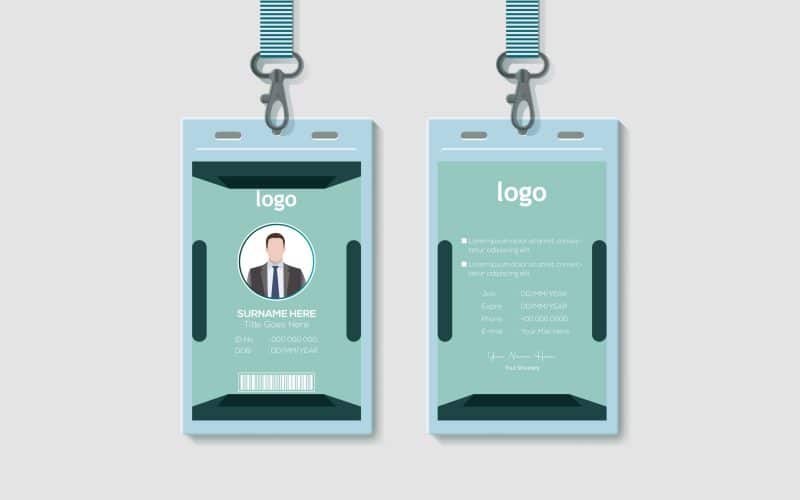Keeping employee records in a secure and accurate manner is no easy task. When you assign employee IDs to your employees, the job becomes less laborious.
In this short article, we’ll go over what an employee ID and ID number are, why they’re useful, and so on.
Let’s get started.
What Is an Employee ID?
An employee ID is a code that is used to identify employees who work for the company. Implementing an employee ID code system in your company can result in healthier employee databases and records, enhanced identity security, and overall increased efficiency. Learn more about employee ID numbers and how they can help you enhance employee management in your firm.
How Should an Employee ID Be Formatted?
For employee IDs, there is no universally accepted format. Employers can develop employee IDs.
Here are a few examples of common employee ID formats:
- Numbers in order of when an employee was hired. For example, 00009 represents an early hire, but 00743 represents a considerably later hire.
- A combination of digits and letters, with the letter representing the employee’s department. For example, ACC1234 could be an employee ID in the accounting department.
- Temporary personnel, such as interns or contractors, have their own codes. For example, TEMP007.
It’s critical to stick to the employee ID format you’ve chosen, as changing it frequently can confuse employees and negate the purpose of the IDs.
If you want your company’s employee IDs to be consistent, they should all come from the same department. For example, you may delegate these employee IDs to your Human Resources department to ensure there are no duplicates and everything is in order.
What is an Employee ID Number?
Employers assign each employee a unique employee ID number code. This identifying code is sometimes known as an employee number, employee code, employee ID, or any other name that sounds similar.
Because employee IDs represent a unique individual, they also reflect their personal information and other vital company information. This can include their address, SSN, payroll information, and other information.
While issuing employee IDs is not required, the benefits become increasingly apparent as a company grows and employs more people. Employee identification cards aren’t necessary for tax purposes, but they can help a company better manage its record-keeping.
What Is the Distinction Between an Employee ID Number and a Payroll Number?
An employee ID differs from a payroll number in one important way.
An employee ID is often assigned by an employer to assist in identifying facts about a specific employee.
A payroll number, on the other hand, serves as an identifier for the position rather than the employee who has that position.
Let’s say Jane works as a content writer for ABC. Jane’s employee ID would remain the same regardless of her position in the organization, as that number is linked to her as an individual.
If she was promoted from a content writer to content marketing manager, her payroll ID would change. Her new payroll ID would correspond to her present position.
Payroll IDs are primarily used for payroll and tax purposes, ensuring that employees are paid what they are due.
HMRC also keeps track of the payroll IDs of employees who work for companies that use the Pay As You Earn (PAYE) payroll system.
Employee ID vs. Social Security Number
Employee identification numbers (IDs) are not the same as Social Security numbers (SSNs). While SSNs are a viable method of identifying persons, they contain sensitive personal information that, if used as an employee ID, may expose individuals to identity theft. Identity thieves can utilize SSNs to produce bogus documents and cause considerable damage to the individual’s ID and the security of the business. As a result, employee IDs should be used for day-to-day and internal identification, whereas SSNs should be utilized only when absolutely essential.
It’s also critical to distinguish between employee ID and payroll ID. While an employee ID is unique to that person, a payroll ID is typically allocated to a certain role or position rather than an individual. That is, if another employee takes over the position, they inherit the payroll ID and its related information but retain their own employee ID.
Employee vs. Employer Identification
Employee ID is frequently confused with Employer ID (EIN). The IRS has assigned you a nine-digit number as your EIN. A business’s EIN, like its SSN, is its unique federal identification number and is utilized for tax, reporting, and regulation purposes.
Who is in Charge of Assigning and Managing Employee IDs?
The responsibility for allocating and managing employee IDs often falls under the purview of the organization’s human resources (HR) department, accountants, or payroll clerks, depending on the size of the organization. After hiring, they usually provide employees with their unique IDs as part of the onboarding process.
Are There Any Guidelines for Employee Identification Numbers?
Because employee ID numbers are frequently visible to the public, you should avoid utilizing sensitive information to generate them, such as the last four digits of the employee’s Social Security number. There are no hard and fast restrictions other than that, as long as the figures make sense inside your organization. To obtain further information on the ID number, you may utilize a combination of letters and digits.
Here are a few tips for maximizing your employee ID numbering scheme:
- To designate the employee’s department or division, start the ID number with a two-letter code.
- Never use the employee ID number of a dismissed employee again. For new employees, always produce a unique, never-before-used number.
- Add a “-[n]” to the end of the employee ID number, where [n] is the number of extra ID badges to be printed for that employee. (For example, an employee ID of “7659-0” indicates that the employee with ID number “7659” received only one employee ID.) This is very beneficial when using badges for access control.
- Some firms provide new workers with a Temporary employee ID number, denoted by a “T” before or after the number, to use until they are issued a permanent number.
- Include a check digit at the end of the ID number to prevent spoofing.
- We advise employee ID numbers to be between 4 and 8 digits long, so they are neither too short nor too long.
- Assign a series of numbers to visitor ID badges ahead of time. You may still track where visitors go without having to print a new visitor badge every time someone comes in.
How to Use Employee Identification Numbers With ID Cards
Employee number badges not only make your IDs look more professional, but they can also help your ID badge program. It may be necessary to register attendance at a professional training session, for example, which would be made easier by having a unique employee ID number. When the employee visits other sites or places, this number may be needed to be logged in a visitor log. Furthermore, the printed number on the badge may correspond to the number encoded in the card’s magstripe, barcode, or QR code, providing another type of auto-identification.
How Do I Find My Employee Identification Number?
You won’t have to deal with this (all-too-common) inquiry if every employee’s ID number is printed on their badge. In our busy day-to-day lives, we already have too many numbers to remember; this simplifies things even more for your team members.
Access Control With Employee ID Cards
Using employee ID cards to regulate access is a brilliant concept. You can have your system log the corresponding employee ID with each use so there is no confusion about who is entering a certain room or area. In reality, most access control systems ask you to provide the employee ID number of the employee to whom the RFID badge is issued. This establishes a link in the access control database between the RFID code, the employee ID, and the cardholder’s name.
Attendance and Timekeeping With Employee ID
Employee ID badges with inbuilt employee ID numbers can be readily configured to function with time clocks. TapTrack, for example, can be configured to receive the number via NFC (near-field communication). The employee ID is used for unique identification in most time and attendance systems, such as Kronos. You can use your IDs to track work times on faraway sites using appropriate time clocks or even NFC phones.
Number Format for Employee IDs
Employee ID numbers don’t have a set template or format. Organizations can use any format for individual codes, but most use a common template to generate and assign new IDs. It might be a random combination of numbers and letters, or it can follow a template that corresponds to information about the employee, such as their job title or start date. Consider the following employee identification examples:
- M028
- S067
The first letters in these samples represent departments, and the numbers show the sequence in which they were hired by the company. Example A refers to an employee employed for the marketing department, while Example B refers to an employee hired later for the sales department.
No personal or sensitive information should be included in employee ID numbers, regardless of how they are formatted. Include no part of the individual’s SSN or other sensitive information in their employee ID.
Benefits of Employee ID Numbers
#1. Use for a variety of purposes
Employee IDs have a variety of applications depending on the business. In a retail business, for example, an employee ID may be necessary to access the till or inventory systems. They may also be compelled to utilize them for employee privileges, such as purchasing products with their employee discount. Employees in an office setting may have different clearance levels that allow them to log in to specific databases using their IDs. This can also give a digital history of employee IDs in case you, your HR, or accounting teams need to audit data.
#2. Control access to and security of information
Managing access to specific information, applications, and even rooms can be beneficial to your company. You can define individual degrees of access or security using employee IDs. A salesperson, for example, may have access to the CRM database but be prohibited access to programs or information unrelated to their role. You can also temporarily assign IDs to visitors that require access to specific areas of the building, such as contractors or clients.
#3. Organize large company datasets
An employee ID system can aid in the organization and upkeep of documents and databases. It is simple to look up, view, and organize information using a single ID tied to all of the employee’s information.
#4. Maintain identity precision
If your company is small, you probably won’t have to worry about names causing confusion in employee records. However, if a company grows, some employees may share the same name, causing problems with record-keeping. This could jeopardize confidentiality or cause payroll issues. You can avoid these problems by adopting an employee ID system that ensures each employee is unique in your company’s records.
Read Also: Digital Employee Experience DEX: The Ultimate Guide
#5. Enhance ID entity security
You can avoid utilizing otherwise personal information by employing unique employee IDs. An employee ID code is a unique internal code that serves as an encryption of the employee’s identification. Employee IDs must be unique and contain no personal information, such as SSNs, that could compromise employee identity.
You can avoid utilizing otherwise personal information by employing unique employee IDs. An employee ID code is a unique internal code that serves as an encryption of the employee’s identification. It is critical that employee IDs are unique and do not include any coworkers.
Summary
It’s never too early to start issuing employee ID numbers if you own a small business. When you only have three employees, it may seem foolish, but when you have 100 or more, you’ll be glad you have a system in place. To allow for growth and development, we always propose that small businesses integrate big-company systems wherever practicable.
- EMPLOYEE ID NUMBER: Meaning, How to Find it, State, Federal & Generator
- HOW TO START PAYROLL FOR SMALL BUSINESS: 2023 Best Easy Guide
- WHAT IS TAX ID: Definition, Types, How and Where to Get It






